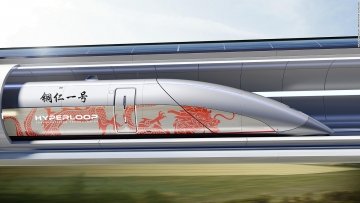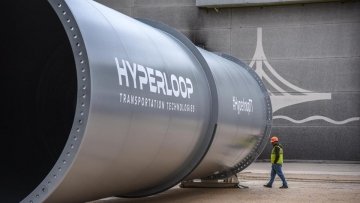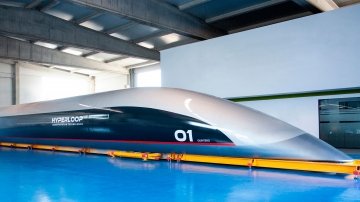
The recently sealed agreement between Hyperloop TT and the government of China to develop a 60 km length track in the province of Guizhou has rocketed the dream of the 1,200 kph (760 mph) fast futuristic transportation. China, which spends over $300 billion a year in infrastructures, has one of the most rapidly growing urban population, and mobility within this large country is a key issue. Hyperloop therefore, rises up as the answer to close the distance between cities in a fast and efficient way.
“In Guizhou, we are foreseeing a six-month feasibility study, and then 38 months to implement the first line. We are talking about an overview of a maximum of five years to add the first passenger in China. Then we are planning to roll out 2,000 kilometers in China,” assured Hyperloop TT co-founder and chairman Bibop Gresta for China Money Network.
Hyperloop comes to address two major issues in today’s modern world. On one side, urban migration will keep growing, as urban population all over the planet is increasing. Globally, it is estimated that there are 740 million internal and 232 million international migrants, moving from no-urban areas towards metropolitan hubs. Bearing in mind those figures, and reporting to the International Organization for Migration (IOM), “many city and local governments fail to consider it in urban development planning,” which points out directly to an underdevelopment of basic infrastructure in many cases.
On the other hand, and as cities keep growing, the needs to find efficient solutions, namely low energy usage, environment friendly and little time consuming, is in the agendas for governments worldwide. While trans-oceanic transport is well covered by planes (and there is no plausible alternative on the table), in-land distances between metropolitan hubs can be addressed in a more sustainable fashion. It is not a surprise then that governments in Europe and Asia seek new models that can account for a more efficient transportation.

The recently agreed partnership between Hyperloop TT and the city of Tongren is the last chapter of a program that has been going on for 5 years . The province of Guizhou, in southeaster China, is relatively poor economically and rather underdeveloped, although it is rich in natural resources. But as in many other parts of Asia, it is waking up at a pace the national government can’t basically keep up, so the need to finding modern and up-to-date technological solutions has become a priority.
“Tongren has always been focused on sustainable development. The signing for Hyperloop project is a major step to open up the inland development, an important achievement of the Tongren Great Investment Action Year, and an important project to enlarge and strengthen the local economy,” said recently Chen Shaorong, Mayor of Tongren, in words collected by PR Newswire. “After the completion of the project, it will greatly accelerate the research and development of China’s hyperloop system, rapidly enhance the development of high-tech industry and equipment manufacturing industry in Guizhou Province, effectively improve the popularity of Tongren city and the development of tourism industry, and laying solid foundation for Tongren ‘one district and five places’ development.”
Hyperloop has been described as a better and smarter travel experience as the next step in transportation development. Passengers and goods will travel in pressurised capsules floating on a frictionless magnetic cushion within the tubes. Capsules are powered by a linear induction motor, an electromagnetic propulsion, and embedded rechargeable batteries. As a result, the system is silent and emission-free.
Plus, it was reported at Hyperloop TT that,
“these capsules are engineered and designed to create a safe and harmonious environment for the passengers, with customized interior for use-based experiences. Each capsule is 30 meters in length and can carry 28 to 40 passengers. Also, the system is designed for capsule departures every forty seconds and a maximum speed of 1,223 km/h. For instance, the system is capable of moving 164,000 passengers a day on one line at full efficiency,”

In fact, a full-scale prototype of these capsules have been already introduced publicly. The company wanted to show what is capable of and an operative module was showcased in Spain at the beginning of October. The Quintero One, as it is known, is like an “airplane without wings”. It weighs 5 tonnes and can hold 30 to 40 passengers at a time. The exterior is made up of carbon fiber composites that Hyperloop TT claims will protect passengers if anything hits the capsule’s exterior.
Europe was chosen to display this first prototype for a reason: the Old Continent shares the same issue as China, of large growing cities far away from each other. And as the Asian country, Europe is looking for more efficient transportation solution to bring closer all major European Capitals. This dream that has been boosted recently after Hyperloop TT revealed plans to build a kilometre-long test track near its research and development centre in Toulouse, France. The prototype will be used over that track once it gets finished by 2019.
Step by step, Hyperloop transportation is becoming something real, touchable and possible. What once was a far cry from tech magnate Elon Musk, now has plans to be implemented in China, Abu Dhabi or Europe. Travelling from Frankfurt to Amsterdam in just 50 min or revitalising the Silk Road between the East and the West at a 1,200 kph speed is a dream that, as Hyperloop aspires to, might soon become a reality.

Hernaldo Turrillo is a writer and author specialised in innovation, AI, DLT, SMEs, trading, investing and new trends in technology and business. He has been working for ztudium group since 2017. He is the editor of openbusinesscouncil.org, tradersdna.com, hedgethink.com, and writes regularly for intelligenthq.com, socialmediacouncil.eu. Hernaldo was born in Spain and finally settled in London, United Kingdom, after a few years of personal growth. Hernaldo finished his Journalism bachelor degree in the University of Seville, Spain, and began working as reporter in the newspaper, Europa Sur, writing about Politics and Society. He also worked as community manager and marketing advisor in Los Barrios, Spain. Innovation, technology, politics and economy are his main interests, with special focus on new trends and ethical projects. He enjoys finding himself getting lost in words, explaining what he understands from the world and helping others. Besides a journalist, he is also a thinker and proactive in digital transformation strategies. Knowledge and ideas have no limits.












